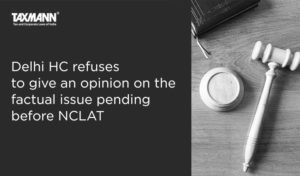Delhi HC refuses to give an opinion on the factual issue pending before NCLAT
- Blog|News|Company Law|
- 2 Min Read
- By Taxmann
- |
- Last Updated on 4 March, 2023

Case Details: Power Infrastructure India v. Union of India - [2023] 147 taxmann.com 554 (HC-Delhi)
Judiciary and Counsel Details
-
- Prathiba M. Singh, J.
- Ms Fereshte D. Sethna, Ms Shivangi Sanghvi, Mohit Tiwari & Ashish Mishra, Advs. for the Petitioner.
- Shiva Lakshmi, CGSC, Ms Srishti Rawat, Deepak Khurana, Ms Nishtha Wadhwa, Ashish Verma, Advs. & M. Theepa GP for the Respondent.
Facts of the Case
In the instant case, the petitioner had filed an appeal against an order of the Adjudicating Authority dated 27.09.2022. The same was stated to be listed before the NCLAT on 09.12.2022. However, on 21.10.2022, the NCLAT issued an order bearing (F.No.10/37/2018-NCLAT) requiring the physical filing of documents before the NCLAT for the purpose of computation of limitation.
Pursuant to which, the apprehension expressed by the petitioner was that the maximum limitation period of 45 days for filing an appeal under section 61 of the Insolvency and Bankruptcy Code, 2016 (IBC, 2016) had expired on 12.11.2022 which was a Saturday.
The petitioner had e-filed an appeal on 11.11.2022, (Friday), and physically filed it on the following Monday i.e. on 14.11.2022 and, thus, the appeal might be dismissed. Thereafter, the petitioner filed a writ seeking the quashing of the NCLAT’s order dated 21.10.2022 to the High Court.
Sec 61 of IBC read as follows –
(1) Notwithstanding anything to the contrary contained under the Companies Act 2013, any person aggrieved by the order of the Adjudicating Authority under this part may prefer an appeal to the National Company Law Appellate Tribunal.
(2) Every appeal under sub-section (1) shall be filed within thirty days before the National Company Law Appellate Tribunal.
High Court Held
The High Court held that since the matter was pending adjudication before the NCLAT, which was a duly constituted Tribunal under section 410, there was no need to give an opinion on the factual issue of whether the appeal was within the limitation period or not.
In this regard, the High Court disposed of the instant petition, leaving the petitioner’s remedies open in accordance with the law upon the decision being taken by the NCLAT.
Disclaimer: The content/information published on the website is only for general information of the user and shall not be construed as legal advice. While the Taxmann has exercised reasonable efforts to ensure the veracity of information/content published, Taxmann shall be under no liability in any manner whatsoever for incorrect information, if any.

Taxmann Publications has a dedicated in-house Research & Editorial Team. This team consists of a team of Chartered Accountants, Company Secretaries, and Lawyers. This team works under the guidance and supervision of editor-in-chief Mr Rakesh Bhargava.
The Research and Editorial Team is responsible for developing reliable and accurate content for the readers. The team follows the six-sigma approach to achieve the benchmark of zero error in its publications and research platforms. The team ensures that the following publication guidelines are thoroughly followed while developing the content:
- The statutory material is obtained only from the authorized and reliable sources
- All the latest developments in the judicial and legislative fields are covered
- Prepare the analytical write-ups on current, controversial, and important issues to help the readers to understand the concept and its implications
- Every content published by Taxmann is complete, accurate and lucid
- All evidence-based statements are supported with proper reference to Section, Circular No., Notification No. or citations
- The golden rules of grammar, style and consistency are thoroughly followed
- Font and size that’s easy to read and remain consistent across all imprint and digital publications are applied





